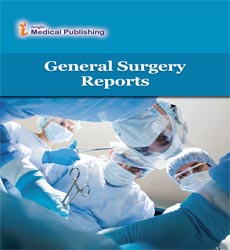Mastectomy and Breast Cancer Survivorship: Challenges and Triumphs
Noah Iliakova*
Department of Surgery, University of Dental Medicine, Boston, USA
- *Corresponding Author:
- Noah Iliakova
Department of Surgery, University of Dental Medicine, Boston,
USA,
E-mail: Iliakova@gmail.com
Received date: May 14, 2024, Manuscript No. IPGSR-24-19067; Editor assigned date: May 16, 2024, PreQC No. IPGSR-24-19067 (PQ); Reviewed date: May 30, 2024, QC No. IPGSR-24-19067; Revised date: June 06, 2024, Manuscript No. IPGSR-24-19067 (R); Published date: June 13, 2024, DOI: 10.36648/2393-8854.11.2.162
Citation: Iliakova N (2024) Mastectomy and Breast Cancer Survivorship: Challenges and Triumphs. Gen Surg Rep 11.2:162.
Description
A mastectomy is a surgical procedure involving the removal of one or both breasts, either partially or completely. It is often performed as a treatment option for breast cancer or as a preventive measure for individuals at high risk of developing breast cancer. The decision to undergo a mastectomy is deeply personal and can be influenced by medical factors, individual preferences, and emotional considerations. Breast cancer is one of the most common forms of cancer affecting women worldwide. While advances in early detection and treatment have improved survival rates, mastectomy remains a critical component of breast cancer management. The goal of a mastectomy is to remove cancerous tissue from the breast and reduce the risk of cancer recurrence. There are several types of mastectomy procedures, each with its own indications and outcomes. A total mastectomy involves the removal of the entire breast, including the breast tissue, nipple and areola. In some cases, the surgeon may also remove nearby lymph nodes to assess the extent of cancer spread.
Muscle tissue
A modified radical mastectomy involves removing the entire breast along with the underlying muscle tissue and some lymph nodes. A skin-sparing mastectomy preserves the breast skin envelope, which can improve the cosmetic outcome of breast reconstruction surgery. For individuals with early-stage breast cancer, a mastectomy may offer the possibility of complete cancer removal while preserving the surrounding healthy tissue. In cases where the cancer is larger or has spread to nearby lymph nodes, a more extensive mastectomy may be necessary to achieve optimal cancer control. Additionally, some individuals may choose to undergo a mastectomy as a preventive measure if they have a strong family history of breast cancer or carry a genetic mutation such as BRCA1 or BRCA2. While mastectomy can be an effective treatment for breast cancer, it can also have profound physical and emotional impacts on individuals. The loss of one or both breasts can affect body image, self-esteem, and sexual identity. Many individuals experience feelings of grief, sadness, or anxiety following mastectomy and may require support from healthcare providers, counselors, or support groups to cope with these emotions.
Reconstruction surgery
In recent years, there has been growing recognition of the importance of breast reconstruction surgery following mastectomy. Breast reconstruction can help restore a sense of wholeness and femininity for individuals who have undergone mastectomy. Reconstruction techniques have evolved significantly, offering a range of options including implants, tissue expanders and autologous tissue transfer (using tissue from other parts of the body). Reconstruction can be performed immediately following mastectomy (immediate reconstruction) or delayed until a later time (delayed reconstruction), depending on individual preferences and medical considerations. In addition to the physical and emotional impacts of mastectomy, there are also practical considerations to take into account. For example, individuals may need to adjust to changes in clothing fit, and daily activities following surgery. They may also require ongoing medical follow-up, including surveillance for cancer recurrence and monitoring for potential complications such as lymphedema (swelling due to lymph node removal) or surgical site infections. Overall, mastectomy is a complex surgical procedure with far-reaching implications for individuals diagnosed with breast cancer or at high risk of developing the disease. It is important for healthcare providers to offer comprehensive support and information to help individuals make informed decisions about their treatment options and navigate the physical, emotional, and practical challenges associated with mastectomy and breast cancer survivorship.
Open Access Journals
- Aquaculture & Veterinary Science
- Chemistry & Chemical Sciences
- Clinical Sciences
- Engineering
- General Science
- Genetics & Molecular Biology
- Health Care & Nursing
- Immunology & Microbiology
- Materials Science
- Mathematics & Physics
- Medical Sciences
- Neurology & Psychiatry
- Oncology & Cancer Science
- Pharmaceutical Sciences
